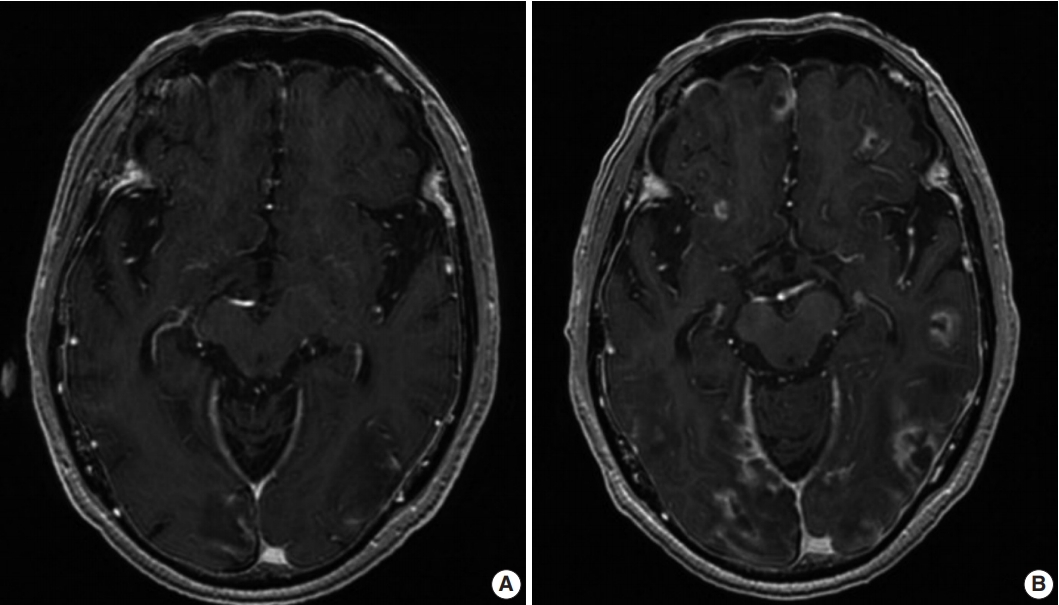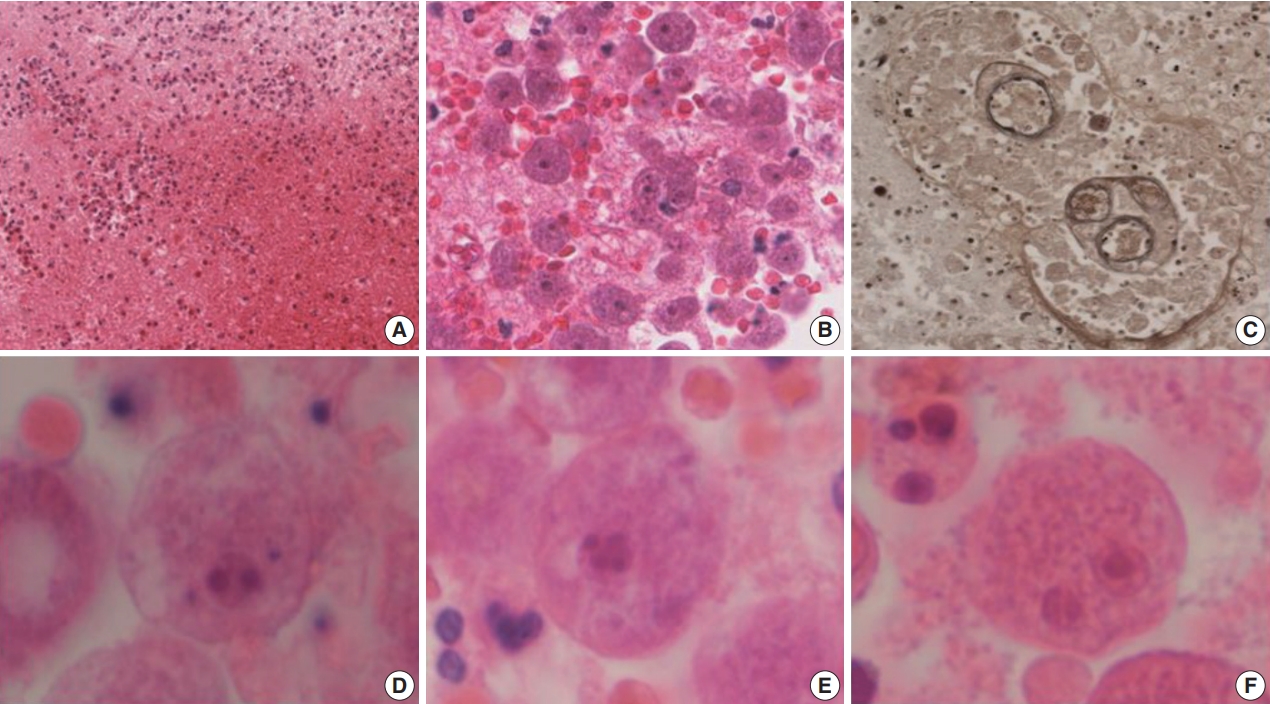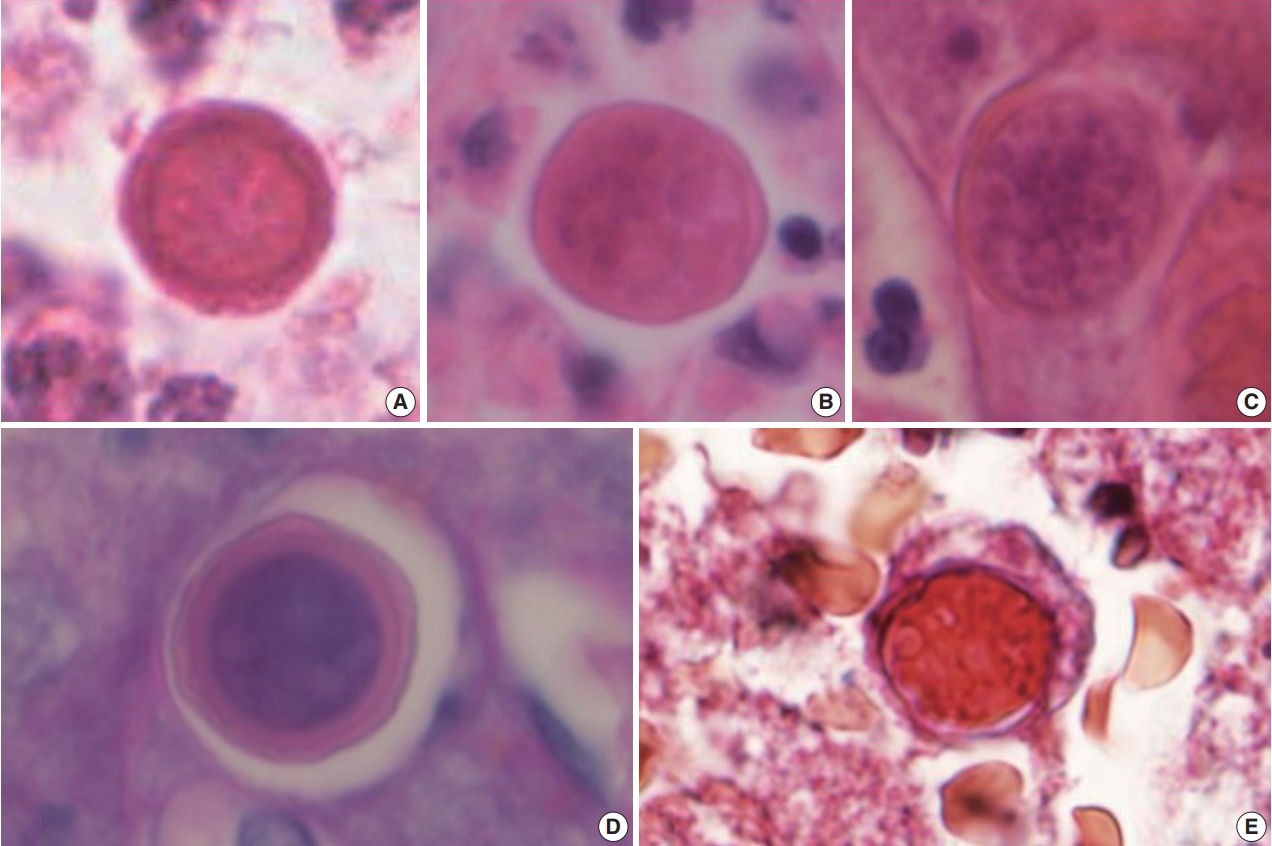Abstract
- We present the case of a 71-year-old man who was diagnosed with amoebic encephalitis caused by Balamuthia mandrillaris. He had rheumatic arthritis for 30 years and had undergone continuous treatment with immunosuppressants. First, he complained of partial spasm from the left thigh to the left upper limb. Magnetic resonance imaging revealed multifocal enhancing nodules in the cortical and subcortical area of both cerebral hemispheres, which were suggestive of brain metastases. However, the patient developed fever with stuporous mentality and an open biopsy was performed immediately. Microscopically, numerous amoebic trophozoites, measuring 20 to 25 µm in size, with nuclei containing one to four nucleoli and some scattered cysts having a double-layered wall were noted in the background of hemorrhagic necrosis. Based on the microscopic findings, amoebic encephalitis caused by Balamuthia mandrillaris was diagnosed. The patient died on the 10th day after being admitted at the hospital. The diagnosis of amoebic encephalitis in the early stage is difficult for clinicians. Moreover, most cases undergo rapid deterioration, resulting in fatal consequences. In this report, we present the first case of B. mandrillaris amoebic encephalitis with fatal progression in a Korean patient.
-
Keywords: Amoebic encephalitis; Balamuthia mandrillaris; Histopathologic features
Although amoebic encephalitis is a rare disease, it has a very high mortality rate. There are two distinct forms of representation of this disease. One is the granulomatous amoebic encephalitis caused by Balamuthia mandrillaris or Acanthamoeba species, which progresses chronically or subacutely, during a period of two weeks to 2 years. The other is the primary amoebic meningoencephalitis caused by Naegleria fowleri, which progresses rapidly and fulminantly, resulting in death within a week or less [1].
Unlike the other amoeba species, B. mandrillaris affects not only immunocompromised but also immunocompetent people, especially the young and the elderly [2]. The histopathologic findings showed a wide spectrum of features from acute and subacute to granulomatous inflammation. In addition, the mortality rate is known to be 98% [3]. Since 1991, B. mandrillaris encephalitis has been reported in more than 200 cases in the world and has predominantly occurred in South America and the United States. However, in East Asia, only nine cases have been reported in Japan [4] and the present patient is the first case of B. mandrillaris encephalitis in the Republic of Korea.
CASE REPORT
- A 71-year-old Korean man presented with partial spasm from the left thigh to the left upper limb for a day without any infectious symptoms at that time. He had had rheumatic arthritis for 30 years and had been continuously treated with immunosuppressants such as steroids, methotrexate, and nonsteroidal antiinflammatory drugs. Initial magnetic resonance imaging (MRI) of the brain revealed several ring-enhancing nodules measuring up to 3.7×3.2×1.8 cm in size in both cerebral hemispheres, and brain metastasis of unknown origin was suspected (Fig. 1A). The initial blood laboratory test revealed an increased C-reactive protein (CRP) level (7.89 mg/dL) and a normal white blood cell count. The cerebrospinal fluid (CSF) study revealed that the glucose level was within the normal range of 60 mg/dL and that the protein level was elevated at 331.8 mg/dL. A week after, the patient complained of fever and stuporous mentality; a second brain MRI performed at that time revealed a number of nodules that were larger in size (Fig. 1B) compared with the initial MRI.
- Therefore, an open biopsy of the brain was performed immediately. During the operation, the frozen sections with squash preparation showed acute inflammation with hemorrhagic necrosis, and no definitive diagnosis could be made. After the operation, the permanent sections showed diffuse or perivascular infiltration of amoebic trophozoites in the background of hemorrhage and necrosis (Fig. 2A–C). The trophozites were ovoid or round and 20–25 µm in size. They each had 1–2 nuclei containing 1–4 nucleoli (Fig. 2D–F). Additionally, some scattered cysts having inner rigid and outer wavy double-layered walls were observed (Fig. 3A–E). These findings were consistent with the diagnosis of B. mandrillaris amoebic encephalitis. Even though the patient was treated with the combination of pentamidine and paromomycin, he died on the 10th day after being admitted to the hospital.
- Ethics statment
- This study was approved by the Institutional Review Board of Keimyung University Dongsan Medical Center, with waiver of informed consent (IRB No. 2019-02-023).
DISCUSSION
-
Balamuthia mandrillaris, Acanthamoeba species, and Naegleria fowleri are known to be free-living amoebae that can cause amoebic encephalitis. B. mandrillaris and Acanthamoeba species mainly cause granulomatous amoebic encephalitis, which shows subacute to chronic progression, while N. fowleri causes primary amoebic meningoencephalitis, which shows a highly acute progression [1]. Unfortunately, all of these amoebae do not have characteristic clinical features; thus, early diagnosis is very difficult for clinicians and the condition is associated with a high mortality rate of over 90% [5].
-
B. mandrillaris amoebic encephalitis is also a fatal condition, and the mortality rate is known to be 98% [3]. It affects not only immunocompromised but also immunocompetent individuals, especially the young and the old [2]. Despite its high mortality rate, the pathophysiology and pathogenesis of B. mandrillaris amoebic encephalitis are not clearly understood. However, it is assumed that the main routes of the infections are through the nasal mucosa or hematogenous spread through the respiratory and cutaneous pathways in a manner similar to other amoebic species. The CSF study did not reveal any organism, but showed a normal or slightly low glucose level and an elevated protein level, which are similar to findings with the presence of Acanthamoeba species [6].
- Like Acanthamoeba species, B. mandrillaris also have two life cycle stages: trophozoite and cyst. Histopathologically, trophozoites have a round to ovoid shape and range from 12 to 60 µm in size. They usually only have a single nucleus, but, occasionally, more than one nucleus can be noticed. Each nucleus contains one to three nucleoli. When they become cysts, they have a triplelayered wall, but, under a light microscope, they are observed to have a double-layered wall: a round and rigid inner wall and wavy outer wall, ranging from 15–30 µm in size [7,8]. The cysts and trophozoites are prominent in the vascular or perivascular area, in the background of acute to granulomatous inflammation with angiitis, hemorrhage, and necrosis.
- In contrast, Acanthamoeba species have vegetative trophozoites with cysts in the tissue. Trophozoites are 15–50 µm in size and contain one vesicular nucleus with one large, centrally placed nucleolus. Cysts range from 15–25 µm in size and have a doublelayered wall. The outer wall is wrinkled with folds and ripples, while the inner wall varies in shape. On the other hand, N. fowleri have only trophozoites without cysts in the brain tissue. Trophozoites are 10–25 µm in size and have one nucleus with one prominent nucleolus in the middle, and are usually observed around vessels, in the background of acute inflammation associated with hemorrhage and necrosis [8].
- For the diagnosis of amoebic encephalitis, it is essential to identify organisms in the tissue or CSF [7,9]. Differential diagnosis of the three amoebae is possible using each of their characteristic histopathologic findings. In the present case, numerous trophozoites and scattered cysts were found in the vessel wall and perivascular area and were seen in association with acute inflammation and diffuse hemorrhagic necrosis. The trophozoites were in round to ovoid shape, having 1–2 nuclei, and each of them contained 1–4 nucleoli. The cysts were round to ovoid shape, had a double-layered wall, and measured 15–20 µm in size. While the inner layer was round and rigid, the outer layer was wavy, which is consistent with the features of B. mandrillaris. The characteristic histopathologic features of the three amoebae are listed in Table 1.
- In the CSF study, the glucose level was in the normal range of 60 mg/dL and the protein level was elevated at 331.8 mg/dL, which is consistent with any of the amoebic encephalitis types. Unfortunately, a culture or pathologic smear of CSF was not performed. The CRP level in the blood was increased to 7.89 mg/ dL, and the white blood cell count was normal. Additionally, an immunofluorescence study or polymerase chain reaction can be used to identify the specific organism. However, in the present case, using only the amoeba-specific histopathologic features was sufficient to identify B. mandrillaris, and this emphasizes the importance of examining the histopathological features of the amoebae.
Author contributions
Conceptualization: SPK.
Data curation: SJK.
Formal analysis: HRJ, MC.
Investigation: SJK, HWL.
Project administration: SPK.
Supervision: SPK.
Validation: HWL, HRJ, MC.
Writing—original draft: SJK, SPK.
Writing—review & editing: SJK, HWL, HRJ, MC, SPK.
Conflicts of Interest
The authors declare that they have no potential conflicts of interest.
Funding
No funding to declare.
Fig. 1.(A) Initial magnetic resonance imaging (MRI) showing multiple ring-enhancing nodules in the cortical and subcortical areas of both cerebral hemispheres. (B) Second MRI showing an increased number and size of the nodules compared to the initial MRI.

Fig. 2.Hemorrhagic necrosis (A) is associated with diffuse or perivascular infiltration of amoebic trophozoites (B, C). (C) Elastic stain highlights the trophozoites. Ovoid to round trophozoites, measuring 20 to 25 µm in size, with 1–2 nuclei containing 1–4 nucleoli are noted (D–F).

Fig. 3.(A–E) Spherical cysts, measuring 15–20 µm in size, consisting of a rigid double-layered wall are noted. The periodic-acid Schiff (D) and trichrome (E) stains highlight the cysts.

Table 1.Differential diagnosis of amoebic encephalitis by histopathologic features
|
Present case |
Balamuthia mandrillaris
|
Acanthamoeba spp. |
Naegleria fowleri
|
|
Trophozoite |
|
|
|
|
|
Size (µm) |
20–25 |
12–60 |
15–50 |
10–25 |
|
Nuclei |
1–2 |
1–3 |
1 |
1 |
|
Nucleoli |
1–4 |
≥ 1 |
1 |
1 |
|
Cyst |
|
|
|
|
|
Size (µm) |
15–20 |
15–30 |
15–25 |
Not identified |
|
Double layer wall |
|
|
|
|
|
Outer |
Wavy |
Wavy |
Wrinkled |
Not identified |
|
Inner |
Round |
Round and rigid |
Various shape |
Not identified |
|
Background |
Acute inflammation |
Acute to granulomatous inflammation (GAE) |
Granulomatous inflammation (GAE) |
Acute inflammation (PAM) |
|
Angiitis |
Angiitis |
Angiitis |
|
|
CSF study |
Not done |
Not identified |
Usually absent (if present, in trophozoite form) |
Present, in flagellate form |
|
Others |
|
|
Keratitis |
|
|
|
|
Skin infection |
|
REFERENCES
- 1. Martinez AJ. Infection of the central nervous system due to Acanthamoeba. Rev Infect Dis 1991; 13 Suppl 5: S399-402. ArticlePubMedPDF
- 2. Diaz JH. The public health threat from Balamuthia mandrillaris in the southern United States. J La State Med Soc 2011; 163: 197-204. PubMed
- 3. Matin A, Siddiqui R, Jayasekera S, Khan NA. Increasing importance of Balamuthia mandrillaris. Clin Microbiol Rev 2008; 21: 435-48. ArticlePubMedPMCPDF
- 4. Itoh K, Yagita K, Nozaki T, et al. An autopsy case of Balamuthia mandrillaris amoebic encephalitis, a rare emerging infectious disease, with a brief review of the cases reported in Japan. Neuropathology 2015; 35: 64-9. ArticlePubMed
- 5. Diaz JH. Behavioral and recreational risk factors for free-living amebic infections. J Travel Med 2011; 18: 130-7. ArticlePubMedPDF
- 6. Kiderlen AF, Laube U. Balamuthia mandrillaris, an opportunistic agent of granulomatous amebic encephalitis, infects the brain via the olfactory nerve pathway. Parasitol Res 2004; 94: 49-52. ArticlePubMedPDF
- 7. Visvesvara GS, Schuster FL, Martinez AJ. Balamuthia mandrillaris, N. G., N. Sp., agent of amebic meningoencephalitis in humans and other animals. J Eukaryot Microbiol 1993; 40: 504-14. ArticlePubMed
- 8. Visvesvara GS, Moura H, Schuster FL. Pathogenic and opportunistic free-living amoebae: Acanthamoeba spp., Balamuthia mandrillaris, Naegleria fowleri, and Sappinia diploidea. FEMS Immunol Med Microbiol 2007; 50: 1-26. ArticlePubMedPDF
- 9. Reddy R, Vijayasaradhi M, Uppin MS, Challa S, Jabeen A, Borghain R. Acanthamoeba meningoencephalitis in an immunocompetent patient: an autopsy case report. Neuropathology 2011; 31: 183-7. ArticlePubMed
Citations
Citations to this article as recorded by

- The role of plasma metagenomic sequencing in identification of Balamuthia mandrillaris encephalitis
Sarah Y. Edminster, Ryan W. Rebbe, Christopher Khatchadourian, Kyle M. Hurth, Anna J. Mathew, Julie Huss-Bawab, Mark S. Shiroishi, Devin Clark, Andrew P. Norgan, Susan M. Butler-Wu, Annie Hiniker
Acta Neuropathologica Communications.2025;[Epub] CrossRef -
Understanding
Naegleria fowleri
: The Risks of Brain Infection
Pankti C. Balar, Savan Modi, Vivek P. Chavda
Outbreak Management and Response.2025;[Epub] CrossRef - Strain-dependent immune responses reveal a critical role of IL-17A in defense against Balamuthia mandrillaris
Yu Jin Jeong, Dong Gyu Han, Mi Kyung Park, Seo Yeong Choi, Shin Ae Kang, Hak Sun Yu
Parasites, Hosts and Diseases.2025; 63(4): 371. CrossRef - Molecular identification, phylogenetic analysis and histopathological study of pathogenic free-living amoebae isolated from discus fish (Symphysodon aequifasciatus) in Iran: 2020–2022
Hooman Rahmati-Holasoo, Maryam Niyyati, Marziye Fatemi, Fatemeh Mahdavi Abhari, Sara Shokrpoor, Alireza Nassiri, Amin Marandi
BMC Veterinary Research.2024;[Epub] CrossRef - Encephalomyelomeningitis Caused by Balamuthia mandrillaris: A Case Report and Literature Review
XueMei Fan, TianWen Chen, Hui Yang, Yue Gao, Yan Chen
Infection and Drug Resistance.2023; Volume 16: 727. CrossRef - Diagnosing Balamuthia mandrillaris amebic meningoencephalitis in a 64-year-old woman from the Southwest of China
Suhua Yao, Xiaoting Chen, Lian Qian, Shizheng Sun, Chunjing Zhao, Zongkai Bai, Zhaofang Chen, Youcong Wu
Parasites, Hosts and Diseases.2023; 61(2): 183. CrossRef - Diagnosis of Balamuthia mandrillaris Encephalitis by Thymine–Adenine Cloning Using Universal Eukaryotic Primers
Ju Yeong Kim, Myung-Hee Yi, Myungjun Kim, Joon-Sup Yeom, Hyun Dong Yoo, Seong Min Kim, Tai-Soon Yong
Annals of Laboratory Medicine.2022; 42(2): 196. CrossRef - Facial Balamuthia mandrillaris infection with neurological involvement in an immunocompetent child
Zhen Zhang, Jianying Liang, Ruoqu Wei, Xiaobo Feng, Lei Wang, Liuhui Wang, Piaoping Zhao, Hong Yu, Yan Gu, Zhirong Yao
The Lancet Infectious Diseases.2022; 22(3): e93. CrossRef - Subacute Balamuthia mandrillaris encephalitis in an immunocompetent patient diagnosed by next-generation sequencing
Changbo Xu, Xiaoyan Wu, Miaoqin Tan, Dongmei Wang, Shengnan Wang, Yongming Wu
Journal of International Medical Research.2022;[Epub] CrossRef - Distribution and Current State of Molecular Genetic Characterization in Pathogenic Free-Living Amoebae
Alejandro Otero-Ruiz, Leobardo Daniel Gonzalez-Zuñiga, Libia Zulema Rodriguez-Anaya, Luis Fernando Lares-Jiménez, Jose Reyes Gonzalez-Galaviz, Fernando Lares-Villa
Pathogens.2022; 11(10): 1199. CrossRef - Fulminant Disseminating Fatal Granulomatous Amebic Encephalitis: The First Case Report in an Immunocompetent Patient in South Korea
Ju Yeon Lee, In Kyu Yu, Seong Min Kim, Joo Heon Kim, Ha Youn Kim
Yonsei Medical Journal.2021; 62(6): 563. CrossRef - A Japanese case of amoebic meningoencephalitis initially diagnosed by cerebrospinal fluid cytology
Ryogo Aoki, Toshimasa Sakakima, Asuka Ohashi, Riyoko Niwa, Masashi Matsuyama, Fumimasa Etori, Naoki Watanabe, Kenji Yagita, Takuji Tanaka
Clinical Case Reports.2020; 8(9): 1728. CrossRef -
Balamuthia mandrillaris
infection in China: a retrospective report of 28 cases
Lei Wang, Wenjing Cheng, Bing Li, Zhe Jian, Xianlong Qi, Dongjie Sun, Jian Gao, Xuetao Lu, Yi Yang, Kun Lin, Chuanlong Lu, Jiaxi Chen, Chunying Li, Gang Wang, Tianwen Gao
Emerging Microbes & Infections.2020; 9(1): 2348. CrossRef - Methotrexate/nonsteroidal anti-inflammatory drugs/steroids
Reactions Weekly.2019; 1775(1): 307. CrossRef - Identification of plicamycin, TG02, panobinostat, lestaurtinib, and GDC-0084 as promising compounds for the treatment of central nervous system infections caused by the free-living amebae Naegleria, Acanthamoeba and Balamuthia
Monica M. Kangussu-Marcolino, Gretchen M. Ehrenkaufer, Emily Chen, Anjan Debnath, Upinder Singh
International Journal for Parasitology: Drugs and Drug Resistance.2019; 11: 80. CrossRef
 , Hye Won Lee
, Hye Won Lee , Hye Ra Jung
, Hye Ra Jung , Misun Choe
, Misun Choe , Sang Pyo Kim,
, Sang Pyo Kim,


 PubReader
PubReader ePub Link
ePub Link Cite this Article
Cite this Article




 E-submission
E-submission








